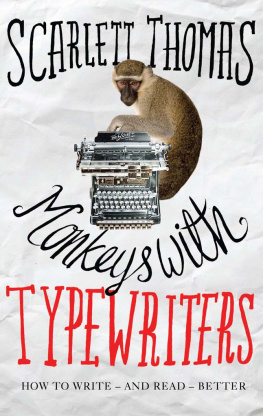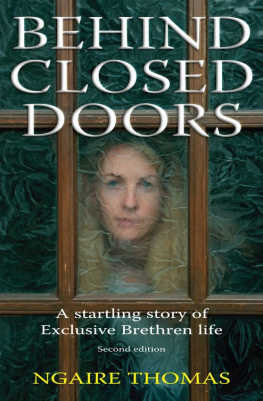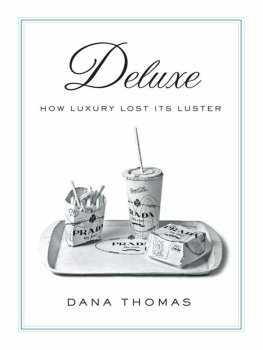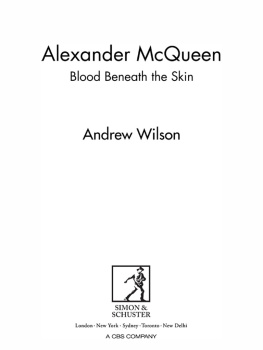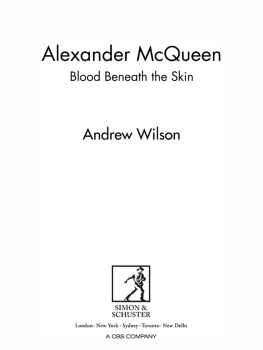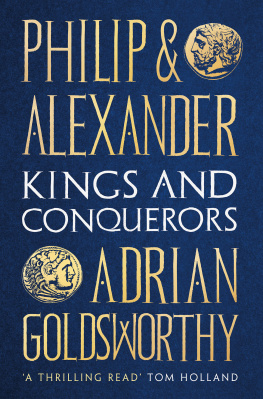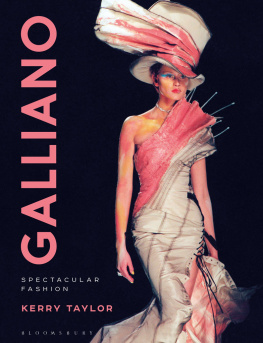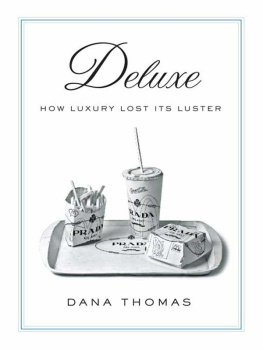Contents
Dana Thomas
GODS AND KINGS
The Rise and Fall of Alexander McQueen and John Galliano
ALLEN LANE
UK | USA | Canada | Ireland | Australia
India | New Zealand | South Africa
Penguin Books is part of the Penguin Random House group of companies whose addresses can be found at global.penguinrandomhouse.com.
First published in the United States of America by Penguin Press, a member of Penguin Group (USA) LLC 2015
First published in Great Britain by Allen Lane 2015
Copyright Dana Thomas, 2015
Cover photograph: Richard Young / Rex Features
Excerpts from transcripts of Charlie Rose broadcasts: interview with Alexander McQueen (November 17, 1997) and with John Galliano (June 13, 2013). Courtesy of Charlie Rose Inc.
The moral right of the author has been asserted
ISBN: 978-1-846-14615-2
THE BEGINNING
Let the conversation begin...
Follow the Penguin Twitter.com@penguinukbooks
Keep up-to-date with all our stories YouTube.com/penguinbooks
Pin Penguin Books to your Pinterest
Like Penguin Books on Facebook.com/penguinbooks
Listen to Penguin at SoundCloud.com/penguin-books
Find out more about the author and
discover more stories like this at Penguin.co.uk
BY THE SAME AUTHOR
Deluxe: How Luxury Lost Its Lustre
For my parents,
Charles H. Thomas
and
Susie S. Thomas
Introduction
On the evening of 24 February 2011, thirty-five-year-old Graldine Bloch, the head of exhibitions at Pariss Institute of the Arab World, and her boyfriend, forty-one-year-old Philippe Virgitti, who worked as a receptionist, were sitting on the terrace of the Paris caf La Perle, chatting over a couple of beers, when the man next to them yelled at them to quiet down. Realizing that he was drunk his eyes were glassy and his speech was slurred they brushed him off. But he kept needling them.
annoying me, he snarled. Youre speaking too loudly.
, standing a few feet away, saw that the situation was quickly devolving into a fight and Bloch was getting upset. He rang his bosss lawyer on a cell phone and tried to pass the phone to Bloch so the lawyer could calm her down, but she refused to take the call. A security guard suggested she move to another table.
, the drunk man grabbed her hair and shouted, Dirty Jew face, you should be dead. She screamed in pain. Shut your mouth, dirty bitch, he snapped. I cant stand your dirty whore voice.
He then turned his anger toward Virgitti and yelled: Fucking Asian bastard, Ill kill you! As Bloch continued to shriek, the drunk told her: Youre so ugly. I cant bear looking at you. Youre wearing cheap boots, cheap thigh boots. Youve got no hair, your eyebrows are ugly, youre ugly, youre nothing but a whore.
Then he let her go, stood up, struck a rock star-like pose and proudly declared in a posh English accent: I am the designer John Galliano!
W HEN THE NEWS BROKE the next morning that the creative director of the esteemed French couture house Christian Dior had been arrested for fighting and shouting anti-Semitic slurs an act that is considered a hate crime in France no one in fashion knew quite what to think. Diors owner Bernard Arnault and the companys chief executive Sidney Toledano a French Jew who is one of the most respected executives in the business responded cautiously by simply suspending Galliano pending the police investigation.
But a few days later in the thick of Paris Fashion Week the British tabloid the Sun published a video on its website of Galliano at the same caf several months earlier, obviously plastered and spewing decidedly more virulent anti-Semitic insults, including I love Hitler, at a couple of patrons, neither of whom were Jewish. The video went viral and the international Jewish community was outraged. Abraham Foxman, national director of the Anti-Defamation League, called Galliano a serial bigot.
It was more than Arnault and Toledano could accept. Within twenty-four hours, they fired Galliano from both Dior and his namesake brand John Galliano. The news of his sacking played on front pages around the world, right next to the revolt in Libya.
Though personally wounded by Gallianos vicious racist outbursts, Toledano chose to go ahead with the Dior womenswear show as scheduled, in a large tent pitched in the Muse Rodins gardens. As the lights went down, he came out and told the audience: What has happened over the last week has been a terrible and wrenching ordeal for us all. It has been deeply painful to see the Dior name associated with the disgraceful statements attributed to its designer, however brilliant he may be. With that came a charming, commercial collection of hippie-inspired clothes, and at the close, in Gallianos absence, Diors hardworking atelier hands, mostly older women, dressed in white smocklike coats, stepped into the spotlight and humbly took the bow.
Gallianos flame-out came almost a year to the day after his competitor and compatriot, the forty-year-old British designer Alexander McQueen, was found dead in his London flat. After years of serious drug abuse and profound depression that his psychiatrist Dr Stephen Pereira later testified was caused by work pressures and accentuated by the death earlier in the week of his devoted mother Joyce, McQueen hanged himself in his wardrobe.
The coincidence in timing was both disturbing and poignant. Galliano and McQueen had arrived on the international fashion stage almost simultaneously in the mid-1990s, when the dominant style was minimalism, and together they shook the industry out of its boring, bourgeois stupor with their innovative, complicated and deeply seductive designs.
Galliano and McQueen had similar personal stories. Both grew up in working-class London Galliano, the son of a plumber; McQueen, the son of a taxi driver with doting mothers who nourished their love of fashion. Both discovered as boys that they were gay and were bullied by homophobic schoolmates, which pushed them to develop violent tempers and mouthy retorts as retaliation. Both apprenticed in the costume departments of London theatres, where they cultivated a taste and an eye for elaborate stage production. Both became regulars on the London nightclub scene and partook in its vices. And both attended Central Saint Martins, a then-little-known but respected art school in London, where they put on exceptional graduation shows.
Galliano and McQueen werent simply driven and gifted. They wanted to revolutionize fashion in a way no one had in decades. With little money, volunteer helpers and sheer will, they turned out landmark collections in mesmerizing, theatrical shows that retailers and critics still gush about and designers continue to reference.
Galliano led the way with his sensual bias-cut gowns and his voluptuous hourglass tailoring, which he presented in romantic storybook-like settings. whole worlds for every woman no, for every girl, boy, woman, man to explore.


